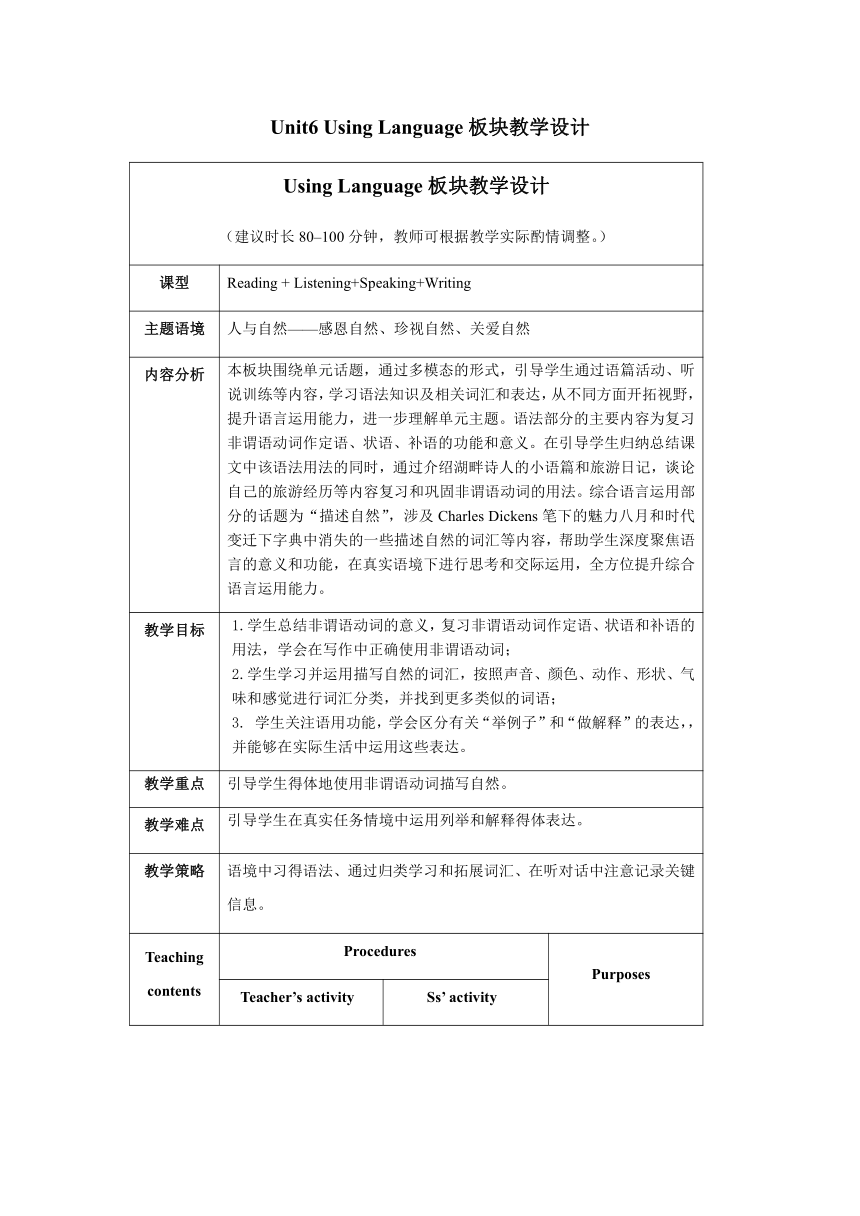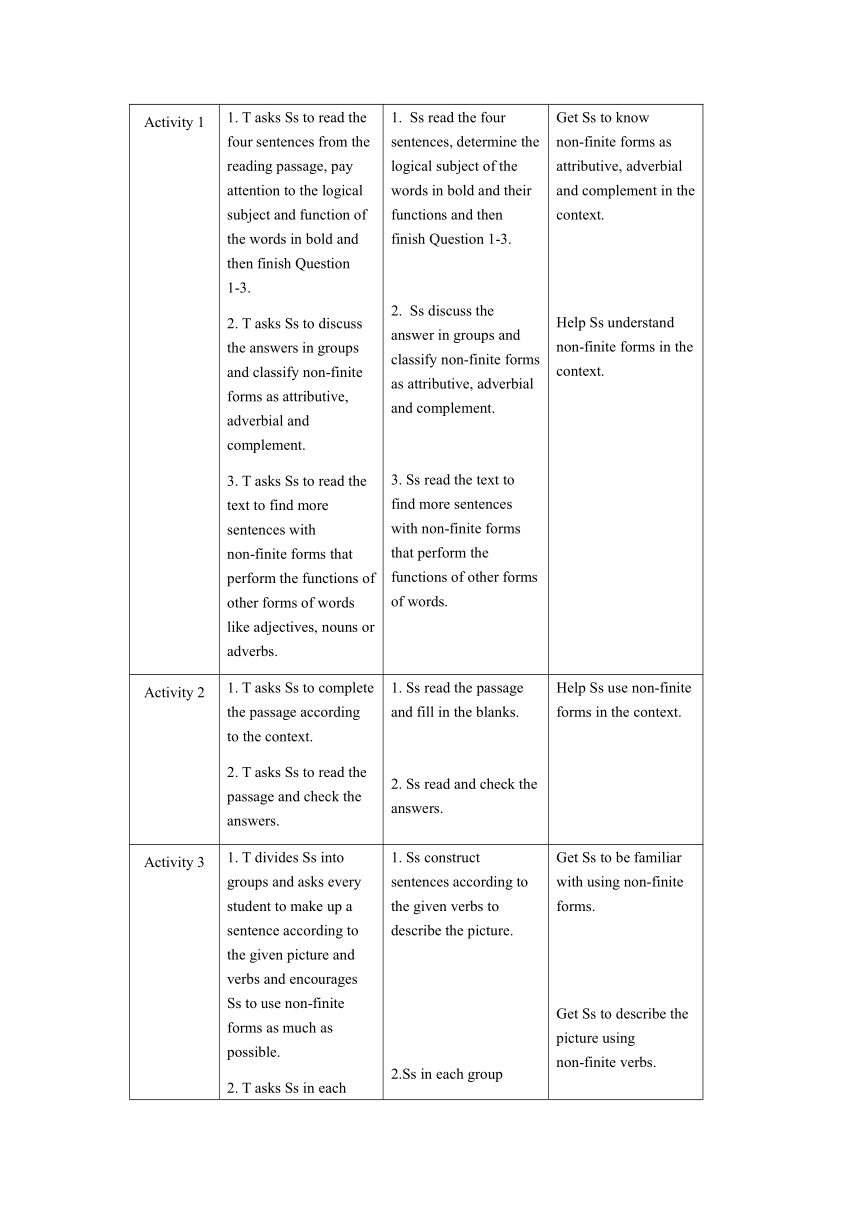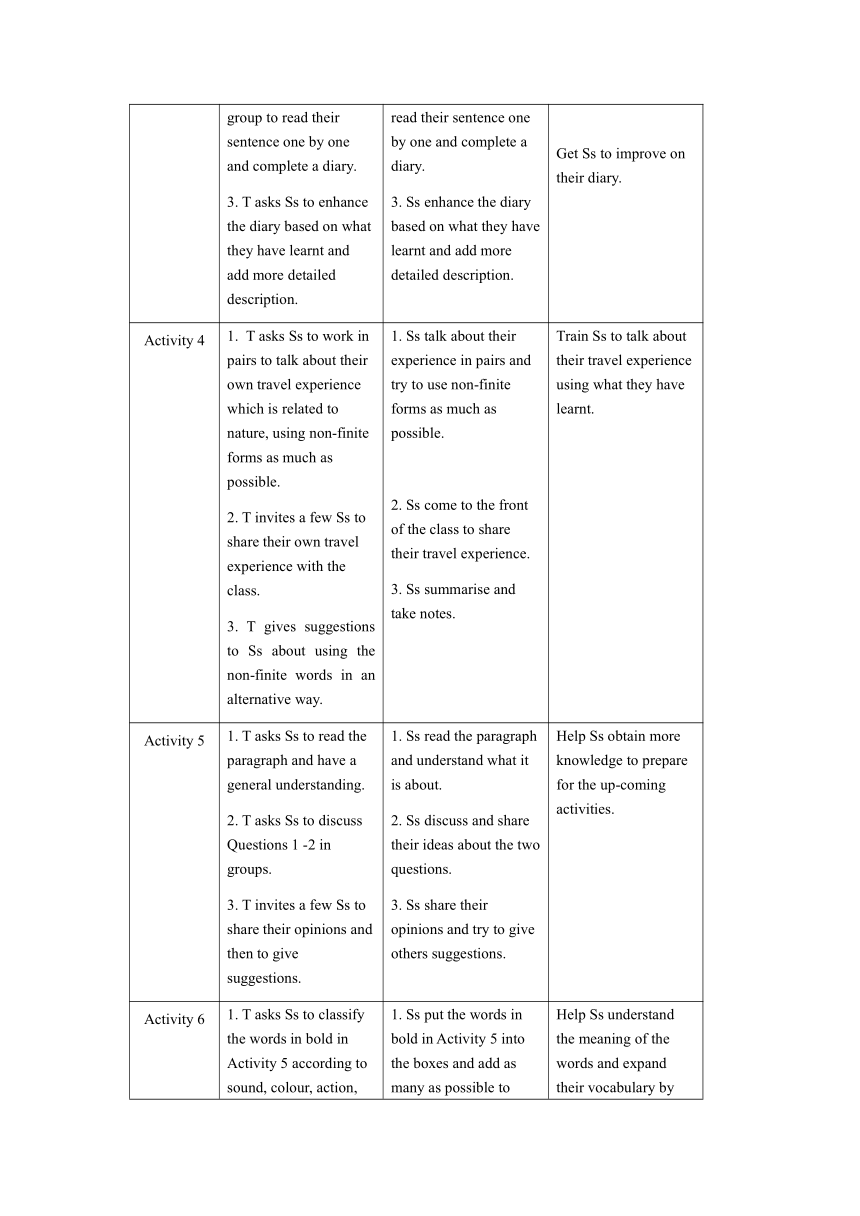外研版(2019)选择性必修第三册 Unit6 Nature in words Using Language板块教学设计
文档属性
| 名称 | 外研版(2019)选择性必修第三册 Unit6 Nature in words Using Language板块教学设计 |

|
|
| 格式 | docx | ||
| 文件大小 | 22.0KB | ||
| 资源类型 | 教案 | ||
| 版本资源 | 外研版(2019) | ||
| 科目 | 英语 | ||
| 更新时间 | 2023-03-06 21:39:26 | ||
图片预览



文档简介
Unit6 Using Language板块教学设计
Using Language板块教学设计 (建议时长80–100分钟,教师可根据教学实际酌情调整。)
课型 Reading + Listening+Speaking+Writing
主题语境 人与自然——感恩自然、珍视自然、关爱自然
内容分析 本板块围绕单元话题,通过多模态的形式,引导学生通过语篇活动、听说训练等内容,学习语法知识及相关词汇和表达,从不同方面开拓视野,提升语言运用能力,进一步理解单元主题。语法部分的主要内容为复习非谓语动词作定语、状语、补语的功能和意义。在引导学生归纳总结课文中该语法用法的同时,通过介绍湖畔诗人的小语篇和旅游日记,谈论自己的旅游经历等内容复习和巩固非谓语动词的用法。综合语言运用部分的话题为“描述自然”,涉及Charles Dickens笔下的魅力八月和时代变迁下字典中消失的一些描述自然的词汇等内容,帮助学生深度聚焦语言的意义和功能,在真实语境下进行思考和交际运用,全方位提升综合语言运用能力。
教学目标 学生总结非谓语动词的意义,复习非谓语动词作定语、状语和补语的用法,学会在写作中正确使用非谓语动词; 学生学习并运用描写自然的词汇,按照声音、颜色、动作、形状、气味和感觉进行词汇分类,并找到更多类似的词语; 3. 学生关注语用功能,学会区分有关“举例子”和“做解释”的表达,,并能够在实际生活中运用这些表达。
教学重点 引导学生得体地使用非谓语动词描写自然。
教学难点 引导学生在真实任务情境中运用列举和解释得体表达。
教学策略 语境中习得语法、通过归类学习和拓展词汇、在听对话中注意记录关键信息。
Teaching contents Procedures Purposes
Teacher’s activity Ss’ activity
Activity 1 1. T asks Ss to read the four sentences from the reading passage, pay attention to the logical subject and function of the words in bold and then finish Question 1-3. 2. T asks Ss to discuss the answers in groups and classify non-finite forms as attributive, adverbial and complement. 3. T asks Ss to read the text to find more sentences with non-finite forms that perform the functions of other forms of words like adjectives, nouns or adverbs. Ss read the four sentences, determine the logical subject of the words in bold and their functions and then finish Question 1-3. Ss discuss the answer in groups and classify non-finite forms as attributive, adverbial and complement. 3. Ss read the text to find more sentences with non-finite forms that perform the functions of other forms of words. Get Ss to know non-finite forms as attributive, adverbial and complement in the context. Help Ss understand non-finite forms in the context.
Activity 2 1. T asks Ss to complete the passage according to the context. 2. T asks Ss to read the passage and check the answers. 1. Ss read the passage and fill in the blanks. 2. Ss read and check the answers. Help Ss use non-finite forms in the context.
Activity 3 1. T divides Ss into groups and asks every student to make up a sentence according to the given picture and verbs and encourages Ss to use non-finite forms as much as possible. 2. T asks Ss in each group to read their sentence one by one and complete a diary. 3. T asks Ss to enhance the diary based on what they have learnt and add more detailed description. 1. Ss construct sentences according to the given verbs to describe the picture. 2.Ss in each group read their sentence one by one and complete a diary. 3. Ss enhance the diary based on what they have learnt and add more detailed description. Get Ss to be familiar with using non-finite forms. Get Ss to describe the picture using non-finite verbs. Get Ss to improve on their diary.
Activity 4 T asks Ss to work in pairs to talk about their own travel experience which is related to nature, using non-finite forms as much as possible. 2. T invites a few Ss to share their own travel experience with the class. 3. T gives suggestions to Ss about using the non-finite words in an alternative way. 1. Ss talk about their experience in pairs and try to use non-finite forms as much as possible. 2. Ss come to the front of the class to share their travel experience. 3. Ss summarise and take notes. Train Ss to talk about their travel experience using what they have learnt.
Activity 5 1. T asks Ss to read the paragraph and have a general understanding. 2. T asks Ss to discuss Questions 1 -2 in groups. 3. T invites a few Ss to share their opinions and then to give suggestions. 1. Ss read the paragraph and understand what it is about. 2. Ss discuss and share their ideas about the two questions. 3. Ss share their opinions and try to give others suggestions. Help Ss obtain more knowledge to prepare for the up-coming activities.
Activity 6 1. T asks Ss to classify the words in bold in Activity 5 according to sound, colour, action, shape, smell, and sensation and add more words to each category. 2. T invites Ss to present the words they can think about and invites more Ss to add more words to expand the vocabulary. 3. T asks Ss to read the paragraph in Activity 5 again and asks Ss to find out what these words are used to describe. Using these as an example, T asks Ss to describe nature in their own way. 4. T asks Ss to use their own collection of words to describe their favorite season. 1. Ss put the words in bold in Activity 5 into the boxes and add as many as possible to each category. Ss exchange words to expand their vocabulary to describe nature. Ss read the paragraph again and find out what these words are used to describe. And then describe nature in their own way, using the example as a reference. 4. Ss discuss and use their own words to describe their favorite season. Help Ss understand the meaning of the words and expand their vocabulary by classifying the words. Help Ss consolidate what they have learnt by practising.
Activity 7 1. T plays the recording and asks Ss to take notes according to Questions 1 to 3. 2. T plays the recording again and asks Ss to finish Questions 1 to 3 according to the notes. 3. T asks Ss to discuss and confirm the answers. 1. Ss listen and take notes. 2. Ss answer the questions according to the notes. 3. Ss discuss and obtain the right answers. Train Ss’listening skills, including detecting key words and taking notes.
Activity 8 1. T asks Ss to read Eric’s blog and try to correct the mistakes based on the listening material. 2. T plays the recording and asks Ss to check the answers. 3. T asks Ss to work in pairs to act out the conversation by playing grandpa and granddaughter’s role. 1. Ss read Eric’s blog and correct the mistakes in it. 2. Ss listen to the recording and check the answers. 3. Ss work in pairs to act out the conversation by playing grandpa and granddaughter’s role. Help Ss get a better understanding of grandpa’s ideas. Help Ss prepare themselves in expressing their own ideas.
Activity 9 T plays the recording and asks Ss to understand and remember the expressions extracted from the Students’ Book. 2. T asks Ss to complete the boxes with the expressions from the conversation. 3. T invites some Ss to read the content in the box. 1. Ss write down the expressions extracted from the Students’ Book.. 2. Ss complete the boxes with the expressions from the conversation. 3. Ss read the information in the chart and confirm the answers. Help Ss grasp the pragmatic functions of these expressions extracted from the Students’ Book while writing an essay to make the content clear and easy to understand.
Activity 10 1. T asks Ss to write down their own opinions on the topic in Activity 8. 2. T asks Ss to discuss their opinions in pairs by giving examples and explanations. 3. T invites a few Ss to give a presentation and then give an assessment. 4. T asks Ss to think about their words and expressions they use independently and share their thinking in the class. 1. Ss write down their own opinions on the topic. 2. Ss improve on their opinions by giving examples and explanations. 3. Some of the Ss give a presentation and others learn from it. 4. Ss think about their words and expressions they use independently and share their thinking in the class. Help Ss express their ideas using “how to give examples and explanations” and have the chance to develop their transferable skills.
Using Language板块教学设计 (建议时长80–100分钟,教师可根据教学实际酌情调整。)
课型 Reading + Listening+Speaking+Writing
主题语境 人与自然——感恩自然、珍视自然、关爱自然
内容分析 本板块围绕单元话题,通过多模态的形式,引导学生通过语篇活动、听说训练等内容,学习语法知识及相关词汇和表达,从不同方面开拓视野,提升语言运用能力,进一步理解单元主题。语法部分的主要内容为复习非谓语动词作定语、状语、补语的功能和意义。在引导学生归纳总结课文中该语法用法的同时,通过介绍湖畔诗人的小语篇和旅游日记,谈论自己的旅游经历等内容复习和巩固非谓语动词的用法。综合语言运用部分的话题为“描述自然”,涉及Charles Dickens笔下的魅力八月和时代变迁下字典中消失的一些描述自然的词汇等内容,帮助学生深度聚焦语言的意义和功能,在真实语境下进行思考和交际运用,全方位提升综合语言运用能力。
教学目标 学生总结非谓语动词的意义,复习非谓语动词作定语、状语和补语的用法,学会在写作中正确使用非谓语动词; 学生学习并运用描写自然的词汇,按照声音、颜色、动作、形状、气味和感觉进行词汇分类,并找到更多类似的词语; 3. 学生关注语用功能,学会区分有关“举例子”和“做解释”的表达,,并能够在实际生活中运用这些表达。
教学重点 引导学生得体地使用非谓语动词描写自然。
教学难点 引导学生在真实任务情境中运用列举和解释得体表达。
教学策略 语境中习得语法、通过归类学习和拓展词汇、在听对话中注意记录关键信息。
Teaching contents Procedures Purposes
Teacher’s activity Ss’ activity
Activity 1 1. T asks Ss to read the four sentences from the reading passage, pay attention to the logical subject and function of the words in bold and then finish Question 1-3. 2. T asks Ss to discuss the answers in groups and classify non-finite forms as attributive, adverbial and complement. 3. T asks Ss to read the text to find more sentences with non-finite forms that perform the functions of other forms of words like adjectives, nouns or adverbs. Ss read the four sentences, determine the logical subject of the words in bold and their functions and then finish Question 1-3. Ss discuss the answer in groups and classify non-finite forms as attributive, adverbial and complement. 3. Ss read the text to find more sentences with non-finite forms that perform the functions of other forms of words. Get Ss to know non-finite forms as attributive, adverbial and complement in the context. Help Ss understand non-finite forms in the context.
Activity 2 1. T asks Ss to complete the passage according to the context. 2. T asks Ss to read the passage and check the answers. 1. Ss read the passage and fill in the blanks. 2. Ss read and check the answers. Help Ss use non-finite forms in the context.
Activity 3 1. T divides Ss into groups and asks every student to make up a sentence according to the given picture and verbs and encourages Ss to use non-finite forms as much as possible. 2. T asks Ss in each group to read their sentence one by one and complete a diary. 3. T asks Ss to enhance the diary based on what they have learnt and add more detailed description. 1. Ss construct sentences according to the given verbs to describe the picture. 2.Ss in each group read their sentence one by one and complete a diary. 3. Ss enhance the diary based on what they have learnt and add more detailed description. Get Ss to be familiar with using non-finite forms. Get Ss to describe the picture using non-finite verbs. Get Ss to improve on their diary.
Activity 4 T asks Ss to work in pairs to talk about their own travel experience which is related to nature, using non-finite forms as much as possible. 2. T invites a few Ss to share their own travel experience with the class. 3. T gives suggestions to Ss about using the non-finite words in an alternative way. 1. Ss talk about their experience in pairs and try to use non-finite forms as much as possible. 2. Ss come to the front of the class to share their travel experience. 3. Ss summarise and take notes. Train Ss to talk about their travel experience using what they have learnt.
Activity 5 1. T asks Ss to read the paragraph and have a general understanding. 2. T asks Ss to discuss Questions 1 -2 in groups. 3. T invites a few Ss to share their opinions and then to give suggestions. 1. Ss read the paragraph and understand what it is about. 2. Ss discuss and share their ideas about the two questions. 3. Ss share their opinions and try to give others suggestions. Help Ss obtain more knowledge to prepare for the up-coming activities.
Activity 6 1. T asks Ss to classify the words in bold in Activity 5 according to sound, colour, action, shape, smell, and sensation and add more words to each category. 2. T invites Ss to present the words they can think about and invites more Ss to add more words to expand the vocabulary. 3. T asks Ss to read the paragraph in Activity 5 again and asks Ss to find out what these words are used to describe. Using these as an example, T asks Ss to describe nature in their own way. 4. T asks Ss to use their own collection of words to describe their favorite season. 1. Ss put the words in bold in Activity 5 into the boxes and add as many as possible to each category. Ss exchange words to expand their vocabulary to describe nature. Ss read the paragraph again and find out what these words are used to describe. And then describe nature in their own way, using the example as a reference. 4. Ss discuss and use their own words to describe their favorite season. Help Ss understand the meaning of the words and expand their vocabulary by classifying the words. Help Ss consolidate what they have learnt by practising.
Activity 7 1. T plays the recording and asks Ss to take notes according to Questions 1 to 3. 2. T plays the recording again and asks Ss to finish Questions 1 to 3 according to the notes. 3. T asks Ss to discuss and confirm the answers. 1. Ss listen and take notes. 2. Ss answer the questions according to the notes. 3. Ss discuss and obtain the right answers. Train Ss’listening skills, including detecting key words and taking notes.
Activity 8 1. T asks Ss to read Eric’s blog and try to correct the mistakes based on the listening material. 2. T plays the recording and asks Ss to check the answers. 3. T asks Ss to work in pairs to act out the conversation by playing grandpa and granddaughter’s role. 1. Ss read Eric’s blog and correct the mistakes in it. 2. Ss listen to the recording and check the answers. 3. Ss work in pairs to act out the conversation by playing grandpa and granddaughter’s role. Help Ss get a better understanding of grandpa’s ideas. Help Ss prepare themselves in expressing their own ideas.
Activity 9 T plays the recording and asks Ss to understand and remember the expressions extracted from the Students’ Book. 2. T asks Ss to complete the boxes with the expressions from the conversation. 3. T invites some Ss to read the content in the box. 1. Ss write down the expressions extracted from the Students’ Book.. 2. Ss complete the boxes with the expressions from the conversation. 3. Ss read the information in the chart and confirm the answers. Help Ss grasp the pragmatic functions of these expressions extracted from the Students’ Book while writing an essay to make the content clear and easy to understand.
Activity 10 1. T asks Ss to write down their own opinions on the topic in Activity 8. 2. T asks Ss to discuss their opinions in pairs by giving examples and explanations. 3. T invites a few Ss to give a presentation and then give an assessment. 4. T asks Ss to think about their words and expressions they use independently and share their thinking in the class. 1. Ss write down their own opinions on the topic. 2. Ss improve on their opinions by giving examples and explanations. 3. Some of the Ss give a presentation and others learn from it. 4. Ss think about their words and expressions they use independently and share their thinking in the class. Help Ss express their ideas using “how to give examples and explanations” and have the chance to develop their transferable skills.
